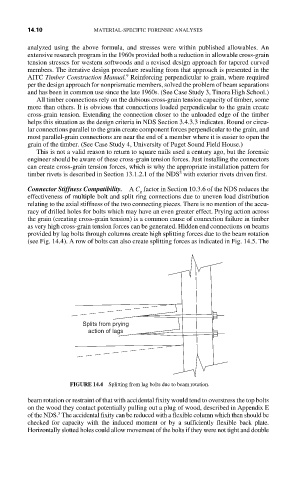Page 519 - Forensic Structural Engineering Handbook
P. 519
14.10 MATERIAL-SPECIFIC FORENSIC ANALYSES
analyzed using the above formula, and stresses were within published allowables. An
extensive research program in the 1960s provided both a reduction in allowable cross-grain
tension stresses for western softwoods and a revised design approach for tapered curved
members. The iterative design procedure resulting from that approach is presented in the
9
AITC Timber Construction Manual. Reinforcing perpendicular to grain, where required
per the design approach for nonprismatic members, solved the problem of beam separations
and has been in common use since the late 1960s. (See Case Study 3, Tinora High School.)
All timber connections rely on the dubious cross-grain tension capacity of timber, some
more than others. It is obvious that connections loaded perpendicular to the grain create
cross-grain tension. Extending the connection closer to the unloaded edge of the timber
helps this situation as the design criteria in NDS Section 3.4.3.3 indicates. Round or circu-
lar connections parallel to the grain create component forces perpendicular to the grain, and
most parallel-grain connections are near the end of a member where it is easier to open the
grain of the timber. (See Case Study 4, University of Puget Sound Field House.)
This is not a valid reason to return to square nails used a century ago, but the forensic
engineer should be aware of these cross-grain tension forces. Just installing the connectors
can create cross-grain tension forces, which is why the appropriate installation pattern for
3
timber rivets is described in Section 13.1.2.1 of the NDS with exterior rivets driven first.
Connector Stiffness Compatibility. A C factor in Section 10.3.6 of the NDS reduces the
g
effectiveness of multiple bolt and split ring connections due to uneven load distribution
relating to the axial stiffness of the two connecting pieces. There is no mention of the accu-
racy of drilled holes for bolts which may have an even greater effect. Prying action across
the grain (creating cross-grain tension) is a common cause of connection failure in timber
as very high cross-grain tension forces can be generated. Hidden end connections on beams
provided by lag bolts through columns create high splitting forces due to the beam rotation
(see Fig. 14.4). A row of bolts can also create splitting forces as indicated in Fig. 14.5. The
Splits from prying
action of lags
FIGURE 14.4 Splitting from lag bolts due to beam rotation.
beam rotation or restraint of that with accidental fixity would tend to overstress the top bolts
on the wood they contact potentially pulling out a plug of wood, described in Appendix E
3
of the NDS. The accidental fixity can be reduced with a flexible column which then should be
checked for capacity with the induced moment or by a sufficiently flexible back plate.
Horizontally slotted holes could allow movement of the bolts if they were not tight and double

